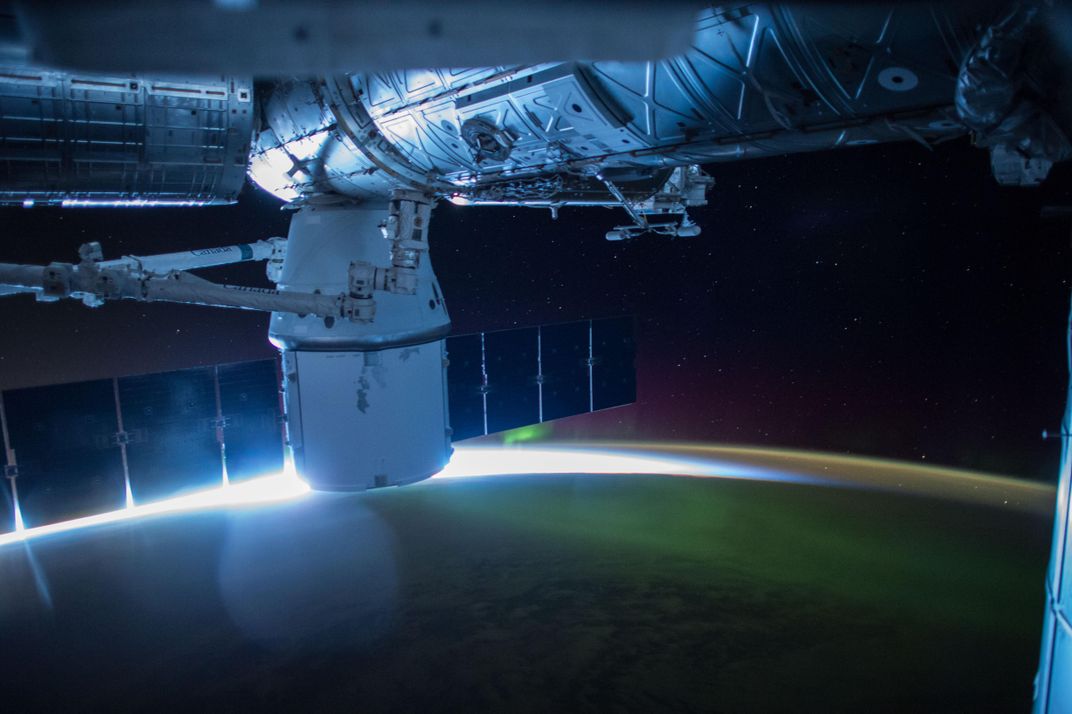SpaceX Successfully Launches a Fully Recycled Mission to the Space Station
A previously flown rocket will launch a previously flown spacecraft to the space station
/https://tf-cmsv2-smithsonianmag-media.s3.amazonaws.com/filer/00/0e/000e0e69-844e-47a2-8514-ff58479f314d/35043398436_3ceaa0098a_o.jpg)
Update 12/15/17: The launch was delayed for several days to conduct a full inspection and cleaning after particles were detected in the (non-reusable) second-stage fuel system. On December 15, 2017, the rocket blasted off at 10:36 am Eastern, successfully delivering the Dragon spacecraft into orbit to rendezvous with the International Space Station on Sunday. The first-stage rocket booster successfully landed at Cape Canaveral. Our original story about the launch can be read below.
On Tuesday, December 12 at 11:46am EST, SpaceX will again test the boundaries of pre-flown spaceflight. Though it may otherwise look like a routine cargo run to the International Space Station, it will be the company’s first using entirely recycled, or "flight-proven," hardware.
SpaceX has already successfully launched both recycled rockets and cargo capsules, but the latest launch will be the first time the company attempts to refly both.The Dragon spacecraft slated for launch was previously used in April 2015 to deliver cargo to a crew on the space station, including astronauts Scott Kelly and Mikhail Kornienko during their Year in Space mission. And the Falcon 9 rocket was launched in June of this year, which Miriam Kramer reported for Mashable was historic for launching a (different) reused Dragon spacecraft for the first time.
Once launched, the Dragon spacecraft will separate from the rocket booster and continue to the space station while the rocket booster will attempt a ground landing at Cape Canaveral.
The spacecraft will deliver 2.4 tons of crew supplies, vehicle hardware, spacewalk equipment, computer resources, and experiments, according to NASA’s press kit. The experiments include an investigation of how plants sense gravity and an acoustic sensor to mount on the outside of the station that will detect vibrations from impacting space debris. After unloading, the Dragon will be reloaded with completed experiments and supplies returning to Earth, detach in January, and splashdown in the Pacific Ocean off the coast of Baja California. Dragon and Soyuz are the only two spacecraft that can currently return cargo from the space station.

The cargo runs are part of SpaceX’s commercial resupply contracts with NASA to provide materials to the International Space Station. This will be the company’s thirteenth resupply mission, the second using a refurbished Dragon capsule. It will also be the first mission for NASA to use a refurbished rocket, and the fourth time SpaceX is re-flying a Falcon 9 rocket since its first success in March 2017. While the rocket and spacecraft have been repaired and returned to flight, the fairings—protective coverings on the rocket’s nose—will be new.
This will be the first time a rocket is using the SLC-40 launch pad at Cape Canaveral in Florida since an accident during a static test fire damaged the pad in September 2016. During a press teleconference on Friday December 8, SpaceX said that costs $50 million to repair and upgrade the pad, including rebuilding propellant, electrical, and data lines and structural support for rockets. Since the accident, SpaceX has been launching from the nearby LC-39A pad at Kennedy Space Center.
This mission marks the end of a big year for SpaceX, their busiest yet with sixteen successful launches not including this cargo run. Of those launches, SpaceX attempted booster recovery for all but three, succeeding with five landings on the ground launchpad and eight on one of their autonomous drone barges. A secretive Zuma satellite was scheduled to launch in November, but is on hold with a new tentative launch window in January.
Catch all the action on Tuesday on NASA or SpaceX livestreams!
Editor's Note: The date for the launchpad explosion has been corrected to September 2016.